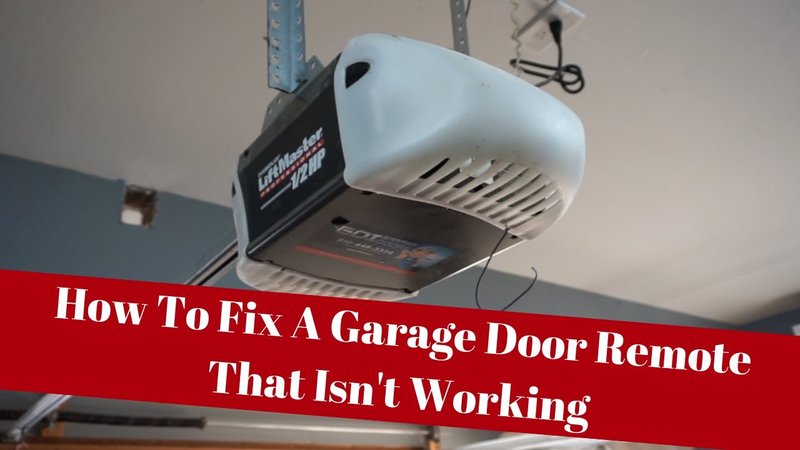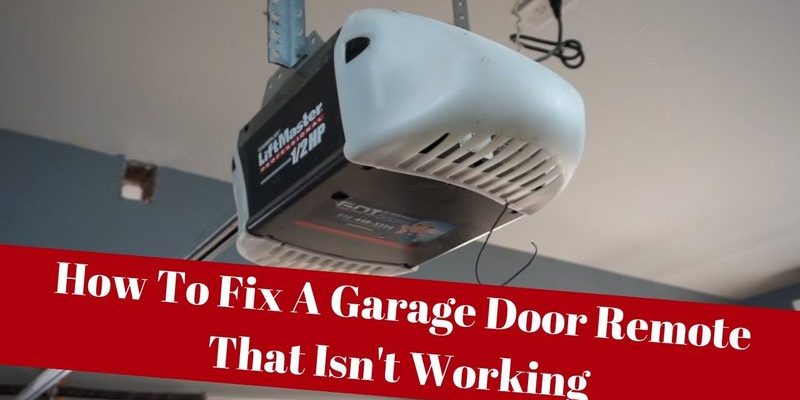
Let’s be real. Most of us expect garage remotes to “just work.” You press the button; the door opens. That’s the deal, right? But when your LiftMaster remote doesn’t open the door consistently, it’s more than just annoying—it’s confusing. If you don’t speak “remote control code” or know about syncing and pairing, this stuff can feel like magic gone wrong. But there’s a method to the madness, and it’s usually pretty fixable once you know where to look.
If you’re new to garage door openers, here’s a quick refresher: The LiftMaster remote is a small handheld device that sends a signal to the motor inside your garage. That motor listens for the right “code” and, if it recognizes it, tells the door to open or close. But when the process breaks down, you’re left on the wrong side of a closed door, remote in hand, wondering what gives.
Common Reasons a LiftMaster Garage Remote Stops Working Reliably
Before grabbing the toolbox, it helps to understand the usual suspects behind a misbehaving remote. Garage remotes might seem simple, but a few moving parts and electronic quirks can throw things off.
Weak or Dying Remote Batteries
Honestly, this is the biggie. Batteries seem like the least exciting part of any device, but even a slightly drained battery can cause all sorts of weirdness. You might find the garage door opens if you stand right by it but refuses to budge from the car. That’s because a weak battery sends a weaker signal, making the opener “hear” you only when you’re super close.
Signal Interference
There’s a lot going on in your garage and neighborhood. Cordless phones, wireless routers, security cameras, even LED lights—these all can crowd the invisible airwaves. Sometimes your LiftMaster remote has to shout over the noise, and if something else is being extra chatty, your door won’t hear the command clearly.
Physical Obstructions
You might be surprised at how easily a big truck, thick walls, or metal shelving can mess with your remote’s signal. Even a closed garage door with heavy insulation can block those tiny radio waves. If your remote only works from close by, check what’s between you and the opener.
Remote Needs to Be Re-Synced or Repaired
Sometimes remotes just “forget” the code—a bit like a phone losing its WiFi password. Power surges, dead batteries, or pressing the wrong button sequence can all knock the remote out of sync. When that happens, pressing the button does nothing because your opener doesn’t recognize the code.
How to Troubleshoot a LiftMaster Remote That Won’t Open the Garage Door
Here’s the thing: before calling in a professional, there are a few steps you can take to get to the root of the problem. Think of this as a checklist for beginners.
Step 1: Check and Replace the Batteries
Start with the easiest fix. Pop open the remote (usually there’s a little slot you can pry open with a coin) and swap in fresh batteries. Make sure they’re facing the right way—yes, it happens to everyone! Test the remote from varying distances to see if things improve.
Step 2: Inspect the Remote for Physical Damage
Remotes take a beating. Maybe it got dropped, or something sticky spilled on the buttons. Any visible cracks or stuck buttons? Give it a gentle clean with a dry cloth, and if the buttons feel mushy or jammed, you might need a new remote.
Step 3: Check for Signal Interference
Look around your garage. Have you added any new gadgets lately? Even a new WiFi extender or a LED bulb can sometimes cause issues. Try unplugging anything new or moving it further from the opener to see if your remote works better.
Step 4: Re-Sync or Re-Pair the Remote
Every LiftMaster opener has a “Learn” button somewhere on the main unit (usually a little red, yellow, or purple square). Hold this button down until the indicator light blinks, then press the button on your remote. If the light blinks again or you hear a click, you’ve paired your remote. This process might sound intimidating, but it’s a bit like pairing Bluetooth earbuds—just follow the blink.
Understanding Garage Door Remote Codes and Security
You might be wondering why your LiftMaster remote needs “codes” in the first place. The answer is security. Older remotes all used the same basic signal, so your neighbor’s remote could open your garage by accident. Not ideal.
Rolling Codes Explained
Newer LiftMaster remotes use rolling codes. Each time you press the button, the code changes to something new. This makes it much harder for someone to “grab” your code from the air and break in. But it also means if the remote and opener lose sync, you’re stuck.
If your remote acts like it’s been locked out, a re-sync or reset is often the best fix, because both the remote and opener need to “agree” on the current code.
When to Reset the Opener
If you’ve tried new batteries and re-syncing but nothing works, you might need to reset the opener itself. This usually involves holding the Learn button for about 10 seconds, which erases ALL paired remotes. Afterward, you’ll need to re-pair each remote.
How Physical Environment Can Mess with Your LiftMaster Remote
Let me explain with a little story: My friend parked in her driveway, pressed the remote, and the door didn’t budge. She backed up a few feet, and—magically—it worked. Turns out, her new metal mail locker was blocking the signal. Seriously, metal is the enemy of radio waves.
Common Physical Barriers
- Large metal objects or shelving units near the opener
- Thick brick or concrete garage walls
- Parked vehicles close to the opener motor
Moving these items, even a little, often helps. Or, if that’s not possible, consider using a remote extender or external antenna.
Weather and Temperature
Believe it or not, extreme cold or heat can mess with electronics. If your garage door remote works perfectly in the spring but acts up in the winter, the temperature could be impacting the battery or the remote’s internal components.
Comparing LiftMaster Remotes with Universal Garage Remotes
You might be tempted to try a universal remote when your original gives you trouble. Here’s what you should know.
Universal Remotes: Pros and Cons
Universal remotes can be great—cheaper and easy to find. They’re also designed to work with a ton of brands, not just LiftMaster. But syncing them can be trickier. Sometimes the codes don’t match perfectly, or you lose some features (like controlling multiple doors).
Brand Remotes: Why Stick with LiftMaster?
LiftMaster remotes are made to speak the exact “language” of your opener. They usually sync quickly and offer better range and reliability. If you’re after peace of mind (and fewer headaches), sticking with the brand remote is almost always worth a few extra bucks.
If your opener is newer (MyQ-enabled or made after 2011), universal remotes may not support all features like smartphone integration or multi-door control.
How to Reset and Program Your LiftMaster Garage Remote
Programming a LiftMaster remote isn’t exactly rocket science, but it does take a few steps. Here’s what most folks need to do:
- Climb a sturdy ladder so you can see the motor unit. Don’t overreach!
- Find the “Learn” button (it might be behind a light cover).
- Press and release the Learn button. Don’t hold it too long, or you’ll wipe all codes.
- Within 30 seconds, press the button on the remote you want to program.
- Listen for the click or flashing light on the motor.
- Test the remote. If it works, you’re golden. If not, repeat the process.
If you have multiple remotes or keypads, you’ll need to program each one. And if you do a full factory reset (by holding the Learn button for 10+ seconds), you’ll have to start from scratch.
When to Replace Your LiftMaster Remote (and What to Watch For)
Sometimes, no troubleshooting or pairing dance will help. If your remote is old, cracked, or has corroded battery contacts, it’s probably time for a new one. Here’s what to look out for:
- The casing is damaged or the buttons are stuck
- It only works after multiple presses, even with new batteries
- The LED light on the remote doesn’t turn on
- Remote works only in certain weather conditions
You might find an exact replacement, or you can try a universal remote if your opener isn’t too new. Just check the compatibility first—LiftMaster remotes made after 2011 use “Security+ 2.0” technology, which not all universals support.
Preventing Remote Problems in the Future
Let me give you a bit of advice: treat your garage remote like you would your car keys. Don’t toss it around. Keep it dry and out of extreme temps. Swap out the batteries every year, even if it still works. It’s cheap insurance.
Also, stay alert for anything new in the garage that might cause interference—new tech gadgets, wireless speakers, even a neighbor’s opener. If you notice your remote range shrinking, act early.
Closing Thoughts on Why Your LiftMaster Garage Remote Won’t Open the Door Consistently
Dealing with a temperamental garage door remote can make you feel powerless, but most issues aren’t as mysterious as they seem. From weak batteries to lost codes, or even that sneaky WiFi router nearby, there’s usually a logical reason why your LiftMaster remote won’t open the door every time. Replacing batteries, re-syncing, and paying attention to interference or physical barriers can solve most problems without a single call to a technician.
If you try all these fixes and still get nowhere, it might be time for a replacement remote or a quick service visit. No gadget lasts forever, but you can usually bring your remote back to life with a little patience—and maybe a spare set of batteries in the glove box. Here’s to smoother arrivals and departures, minus the button-mashing drama.
